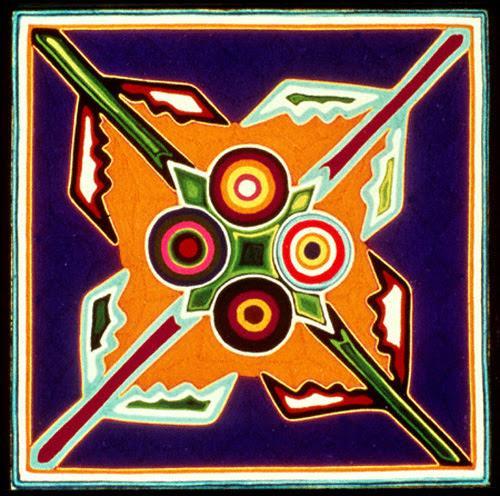The Four Aspects of the Spirit / Yunaukat+ ‘in+ariyari tukarite

The four parts of the spirit converge and are supported above the body by means of four arrows pinned to the cardinal points. These sacred arrows are rooted and nourish the life of the soul, the visions and the heart of our spirit that depend on them.
The muwieri, or arrow below right, bares the green of Our Mother Sea, Tatéi Haramara, in the west. The arrow above right belongs to Wirikuta, the sacred land of the hikuri or peyote. The arrow above left is the Hatuxame River that divides Wixárika territory, issuing from the northern springs of the Hauxa Manaká in Durango. The arrow below left is Xapawiyemetá where there is a wild fig tree in the Waters of the South.
The four circular symbols also represent the four aspects of our spiritual self. Takupiri, our spiritual eye (at upper center), allows us to see the supernatural in our dreams and visions; Tatukari, our life (at right), is our vital energy and our spiritual strength; Tanierika, our spiritual insight (at lower center), is like a mirror that reflects our ancestors and vision that penetrates matter, it is active in our dreams and visions; and Ta‘iyari, our heart at left, besides being a physical organ, is also the guide of our thoughts and contains the memory of our ancestral customs.
The green arrows join at the shaft to form the symbolic barrier of water and matter, and are crossed by the red arrows representing the path of Our Grandfather Fire and Our Father Sun. The circular symbol at right, representing Tatukari, is connected to dawn. Takupiri, the symbol at top, is daytime, while the symbol below, Tanierika, is connected to the night and the underworld (transcendental vision). Ta’iyari, the circular symbol at left, is connected to dusk and to the past. At the center of the arrow shafts is the multi-dimensional level through which the four points connect.
When we die or lose conscience, these invisible aspects of our being also leave our body, and our ‘iyari is released with our breath, ‘iyaya. The thoughts we have in our body as we walk on our way, practicing our devotion, must find rest when we sleep. While our bones and our flesh sleep, our spiritual being is released to travel outside the body.
Explanation and Interpretation by Juan Negrín as explained in a tape-recorded conversation with José Benítez Sánchez. Text and Image ©Juan Negrín 1974 - 2025. All rights digital and print reserved.
-----
Yunaukati tukarite meniuyukuxeirieni tewiyari heimá meniukunamieni, naukame ‘iriki hauku‘utikaikameki mikutetewatsié. ‘Iki ‘irite mimaiwetiká niukatsutiani kipiri katinimikwani, mihekikiá ta‘iyari kipirieya.
Muwieri tserieta hetiana mikawe, Tatéi Haramara katinihetsiemiemetini, miki kanitsiiraiyeni. Heimana tserieta, muwieri muwa kanikaweni wirikuta, hikuri kwieta mikumaiwe. Hutiapaiti ‘utata, muwieri tekanixeiyani Ha Hatuxame wixárika kiekaripa kaniuyehaneni. Muwieri hetiana kanikaweni Xapawiyemeta, ha maneika ‘utata.
Temukukuwetsié temu‘amiwetikatsié, takipiri kaniwatiyeikani tatewiyaritsié ta‘iyari tsiere, ta‘iyari kanitatuamiki, takixairi kanihikitini ta‘iyaritiarika. Ta‘iyaritiarika temexeiya tikariki kaniuka‘uxipiweni, mexi tame tahuyetá te‘uhú ‘ixiarari te‘uwewiximeti ketemiteheuyiwawe. Mexi ta‘umeteyari tawaiyari hapaina, tatukari mexi hawaiki heyeika tatewiyari tsiere.
Naukati xikikirawiti mika‘uxa ‘iniariya takipiri kanihikitini. Takipiri (hixiata hatiana), katinipitiaka taheinitsita temixeiya mihekiare. Tatukari,temayeyuyuri, tatsiwairitia tirikariya temexeiya temuwikwe temu‘uwani. Ta‘iyari kanita‘iyaritini kapititixaiti kanitawikweimiki tatewiyaritsié xika ‘uminé, ta‘iyari ketemitetakuhiawe kaniwitikimetini mana kaniye‘ineni hewixi kememite‘uhukai.





